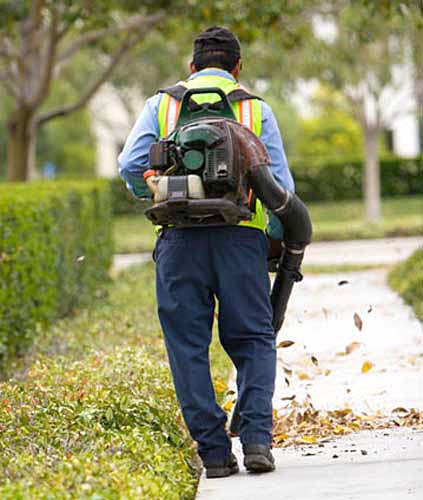Alternatives to Gas-Powered Blowers

IT’S ILLEGAL to use a gas blower in Los Angeles.
California Greenin’ by Renee Ridgeley
Here are some alternatives to using gas-powered blowers
Science quiz: which emits more hydrocarbons into the atmosphere? A half-hour of yard work with a two-stroke leaf blower or driving a Ford F-150 truck from Texas to Alaska? If you thought this a trick question, you’re right, because it’s the blower.
The constant whir of gardeners’ gas blowers can be heard on almost any street, any time, any day. On a windless day, the smell of exhaust hovers longer than the noise.
Gas leaf blowers create pollution, which is why more and more gardeners have taken to wearing masks. Your impulse to close doors and windows on mow and blow day is a good one because the dust and emissions are noxious.
South Coast Air Quality Management District (SCAQMD) estimates that in one year the average blower emits as much pollution as 80 new cars, each driven 12,500 miles. While the hybrid in your driveway is lowering your carbon footprint, that weekly blower is vrooming it up.
American Lung Association’s “Top Ten List of Things You Can Do to Protect Yourself from Unhealthy Air” includes #8: Use hand-powered or electrical lawn care equipment rather than gasoline-powered. It’s just above #9: Don’t allow anyone to smoke indoors. Hmmm, #9 is a cultural no-no while #8 is still a weekly event.
Blowers are bad for human health, bad for the environment and create noise pollution. So what can you do to help clean up your yard, your lungs and your air?
Rake and broom. Those long-handled gardening tools of days gone by are cheap, effective and eco-friendly. They won’t leave behind that fine layer of grit on outdoor furniture, fabrics and tables that comes with a blower.
Gardeners might have to spend more time by using hand-powered equipment. Ask your gardener to use a rake without offering a raise and they might tell you to blow it yourself.
If you can’t increase your monthly expense, suggest keeping the same work load by raking every other week or switch to an hourly rate to ensure crews aren’t asked to do more work for the same amount of money.
Electric and battery-powered blowers. You’ll still get the dust but you can eliminate emissions and mitigate the noise pollution by switching to an electric or battery-powered blower. It has an upfront cost but the health and environmental benefits are irrefutable.
That’s why every fall, the SCAQMD offers a leaf blower exchange program to help offset the costs of switching to greener tools. Commercial landscapers and gardeners can exchange working, gas leaf blowers for a new electric blower that has significantly reduced emission and noise levels. The eco-friendly blowers retail for $470 but, through the rebate, can be purchased for $200.
Fidel Ramirez maintains several Larchmont yards. He didn’t wait for the exchange to upgrade to something greener.
“Last year, I had two customers who wanted electric. This year, I added three more so I bought a battery blower. It’s what the customers want.”
Leave it be. Fallen leaves and grass clippings offer natural mulch to your yard. Leaving freshly mowed blades on the ground helps retain moisture and increases beneficial nutrients.
Move the debris to a pile and you can spin straw into gold— gardeners’ black gold, that is.
Decomposing nitrogen “greens” (grass and kitchen scraps) tossed with carbon “browns” (leaves and paper products) will create compost soil to use later as a natural fertilizer or garden soil.
If the positive incentives aren’t enough to entice you to greener lawn care, how about this one: it’s illegal to use a gas blower in Los Angeles.
Fines are $100, and both homeowner and gardener can be ticketed. The city Bureau of Street Services is assigned with enforcing this law. Don’t worry, they probably won’t start ticketing until they repair the sidewalks.
Category: Real Estate







